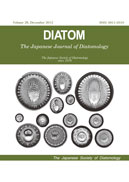25 巻
選択された号の論文の28件中1~28を表示しています
- |<
- <
- 1
- >
- >|
特集:DAIpoを今こそ見つめ直す
-
2009 年 25 巻 p. 1
発行日: 2009/12/25
公開日: 2014/07/12
PDF形式でダウンロード (661K) -
2009 年 25 巻 p. 2-7
発行日: 2009/12/25
公開日: 2014/07/12
PDF形式でダウンロード (692K) -
2009 年 25 巻 p. 8-14
発行日: 2009/12/25
公開日: 2014/07/12
PDF形式でダウンロード (818K) -
2009 年 25 巻 p. 15-20
発行日: 2009/12/25
公開日: 2014/07/12
PDF形式でダウンロード (725K)
論文
-
2009 年 25 巻 p. 21-36
発行日: 2009/12/25
公開日: 2014/07/12
PDF形式でダウンロード (4020K) -
2009 年 25 巻 p. 37-44
発行日: 2009/12/25
公開日: 2014/07/12
PDF形式でダウンロード (1782K) -
2009 年 25 巻 p. 45-51
発行日: 2009/12/25
公開日: 2014/07/12
PDF形式でダウンロード (1372K) -
2009 年 25 巻 p. 52-72
発行日: 2009/12/25
公開日: 2014/07/12
PDF形式でダウンロード (2542K) -
2009 年 25 巻 p. 73-78
発行日: 2009/12/25
公開日: 2014/07/12
PDF形式でダウンロード (812K) -
2009 年 25 巻 p. 79-85
発行日: 2009/12/25
公開日: 2014/07/12
PDF形式でダウンロード (1560K) -
2009 年 25 巻 p. 86-90
発行日: 2009/12/25
公開日: 2014/07/12
PDF形式でダウンロード (2432K) -
2009 年 25 巻 p. 91-105
発行日: 2009/12/25
公開日: 2014/07/12
PDF形式でダウンロード (1432K) -
2009 年 25 巻 p. 106-110
発行日: 2009/12/25
公開日: 2014/07/12
PDF形式でダウンロード (1875K) -
2009 年 25 巻 p. 111-115
発行日: 2009/12/25
公開日: 2014/07/12
PDF形式でダウンロード (1820K) -
2009 年 25 巻 p. 116-119
発行日: 2009/12/25
公開日: 2014/07/12
PDF形式でダウンロード (1126K) -
2009 年 25 巻 p. 120-133
発行日: 2009/12/25
公開日: 2014/07/12
PDF形式でダウンロード (2252K) -
2009 年 25 巻 p. 134-147
発行日: 2009/12/25
公開日: 2014/07/12
PDF形式でダウンロード (1150K) -
2009 年 25 巻 p. 148-152
発行日: 2009/12/25
公開日: 2014/07/12
PDF形式でダウンロード (1848K) -
2009 年 25 巻 p. 153-156
発行日: 2009/12/25
公開日: 2014/07/12
PDF形式でダウンロード (1287K) -
2009 年 25 巻 p. 157-159
発行日: 2009/12/25
公開日: 2014/07/12
PDF形式でダウンロード (2288K) -
2009 年 25 巻 p. 160-163
発行日: 2009/12/25
公開日: 2014/07/12
PDF形式でダウンロード (2444K) -
2009 年 25 巻 p. 164-165
発行日: 2009/12/25
公開日: 2014/07/12
PDF形式でダウンロード (1578K) -
2009 年 25 巻 p. 166-169
発行日: 2009/12/25
公開日: 2014/07/12
PDF形式でダウンロード (1230K)
その他
-
2009 年 25 巻 p. 170-183
発行日: 2009/12/25
公開日: 2014/07/12
PDF形式でダウンロード (1088K) -
2009 年 25 巻 p. 184-185
発行日: 2009/12/25
公開日: 2014/07/12
PDF形式でダウンロード (598K) -
2009 年 25 巻 p. 186-187
発行日: 2009/12/25
公開日: 2014/07/12
PDF形式でダウンロード (906K) -
2009 年 25 巻 p. 188-189
発行日: 2009/12/25
公開日: 2014/07/12
PDF形式でダウンロード (597K) -
2009 年 25 巻 p. 190-192
発行日: 2009/12/25
公開日: 2014/07/12
PDF形式でダウンロード (567K)
- |<
- <
- 1
- >
- >|
